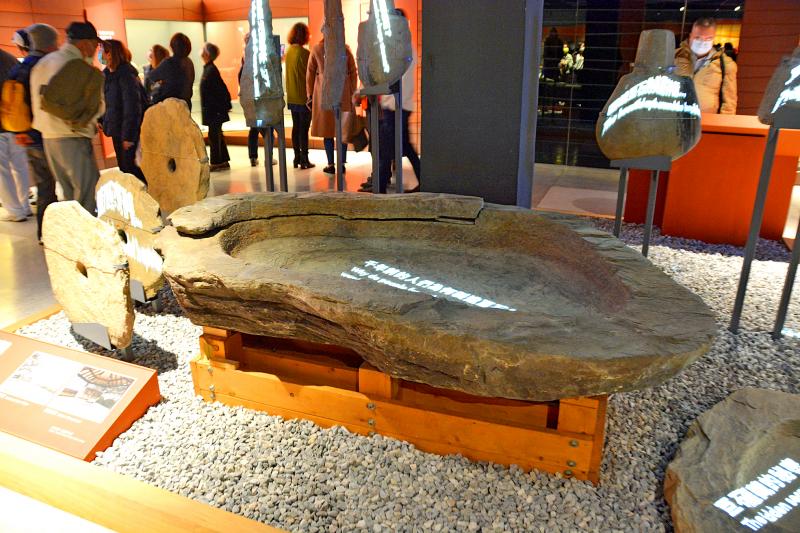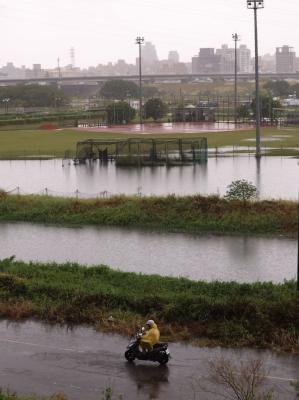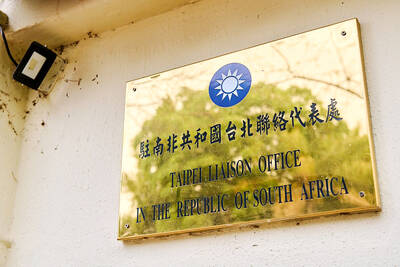The Hualien Archeological Museum opened to the public on Sunday, giving a permanent home to 800,000 artifacts, including a 1,240kg stone trough considered the pride of the museum and a jade burial pendant that inspired its logo design.
To house the museum, the Hualien County Government received a NT$72 million (US$2.54 million) grant from the Ministry of Culture to renovate Shoufeng Township’s (壽豐鄉) Fengtien Market (豐田市場), which was originally built in 1984.
At the opening ceremony, Bureau of Cultural Heritage Deputy Director Wu Hua-tsung (吳華宗) praised the museum as an inspiration to the rest of the nation for providing local historical and cultural education.

Photo: Wang Chun-chi, Taipei Times
The founding of the museum is a large step forward for local archeology, showing that every area has its own history, National Cheng Kung University Institute of Archeology director Liu Yi-chang (劉益昌) said.
Other local governments should emulate Hualien County and bring their artifacts home, he said, adding that he would be willing to personally offer tours in the county to pass on knowledge of past cultures.
The museum is to provide educational programming and conduct research, in addition to storing and displaying artifacts in its three main galleries.
Exhibitions are to focus on the 3,500-year-old jade culture in eastern Taiwan presented from an archeological and experiential perspective, with the goal of getting visitors to “understand the value of historical objects.”
Due to its distinctive design, a 1,000-year-old jade burial pendant serves as a clear representation of the Huakangshan culture (花岡山文化), traces of which were uncovered at an archeological site of the same name on the bank of the Meilun River (美崙溪) in Hualien City and elsewhere in the county.
The artifact inspired the museum’s logo, which intertwines the pendant with an archeological pit to represent continuing dialogue between the past and present.
The museum’s most prized treasure is a massive stone trough, its only artifact that has national cultural asset status, as the rest have yet to be evaluated.
Peng Chun-yuan (彭群元), who donated the trough after it was discovered on his land, said at the opening that he was “happy it is receiving so much attention.”
The quartz and mica slab was found at the Yuemei archeological site (月眉遺址) in Shoufeng Township, which contains artifacts from the Huakangshan culture.
Archeologists believe that it was brought down from the Central Mountain Range, but since trough-shaped stone tools such as this are rare, its purpose is still unknown.
The Hualien County Cultural Affairs Bureau said that entry is free during the soft opening, while operating hours are Wednesday through Sunday from 9am to 5pm.
The museum is to be closed from Lunar New Year’s Eve on Feb. 11 to Feb. 13.

Taipei, New Taipei City, Keelung and Taoyuan would issue a decision at 8pm on whether to cancel work and school tomorrow due to forecasted heavy rain, Keelung Mayor Hsieh Kuo-liang (謝國樑) said today. Hsieh told reporters that absent some pressing reason, the four northern cities would announce the decision jointly at 8pm. Keelung is expected to receive between 300mm and 490mm of rain in the period from 2pm today through 2pm tomorrow, Central Weather Administration data showed. Keelung City Government regulations stipulate that school and work can be canceled if rain totals in mountainous or low-elevation areas are forecast to exceed 350mm in

EVA Airways president Sun Chia-ming (孫嘉明) and other senior executives yesterday bowed in apology over the death of a flight attendant, saying the company has begun improving its health-reporting, review and work coordination mechanisms. “We promise to handle this matter with the utmost responsibility to ensure safer and healthier working conditions for all EVA Air employees,” Sun said. The flight attendant, a woman surnamed Sun (孫), died on Friday last week of undisclosed causes shortly after returning from a work assignment in Milan, Italy, the airline said. Chinese-language media reported that the woman fell ill working on a Taipei-to-Milan flight on Sept. 22

COUNTERMEASURE: Taiwan was to implement controls for 47 tech products bound for South Africa after the latter downgraded and renamed Taipei’s ‘de facto’ offices The Ministry of Foreign Affairs is still reviewing a new agreement proposed by the South African government last month to regulate the status of reciprocal representative offices, Minister of Foreign Affairs Lin Chia-lung (林佳龍) said yesterday. Asked about the latest developments in a year-long controversy over Taiwan’s de facto representative office in South Africa, Lin during a legislative session said that the ministry was consulting with legal experts on the proposed new agreement. While the new proposal offers Taiwan greater flexibility, the ministry does not find it acceptable, Lin said without elaborating. The ministry is still open to resuming retaliatory measures against South

1.4nm WAFERS: While TSMC is gearing up to expand its overseas production, it would also continue to invest in Taiwan, company chairman and CEO C.C. Wei said Taiwan Semiconductor Manufacturing Co (TSMC) has applied for permission to construct a new plant in the Central Taiwan Science Park (中部科學園區), which it would use for the production of new high-speed wafers, the National Science and Technology Council said yesterday. The council, which supervises three major science parks in Taiwan, confirmed that the Central Taiwan Science Park Bureau had received an application on Friday from TSMC, the world’s largest contract chipmaker, to commence work on the new A14 fab. A14 technology, a 1.4 nanometer (nm) process, is designed to drive artificial intelligence transformation by enabling faster computing and greater power